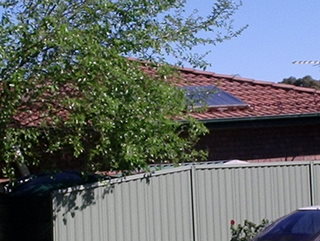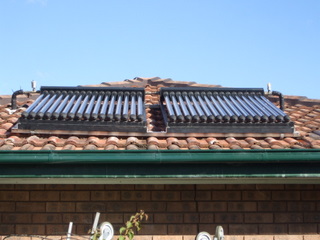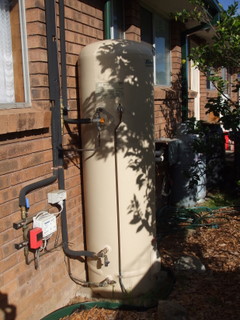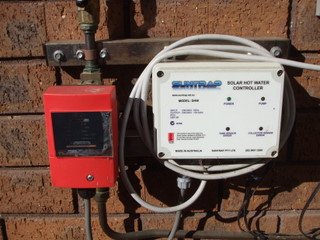When we moved here over 33 years ago the house was new and we had one of those titchy little electric storage water heaters, it must have been only 60 or 80 litres in size, to provide hot water for the house. This was all well and good when it was just the two of us, but once the kids started to put in an appearance it became more difficult. We decided at that point we needed a new improved hot water system and to make it sustainable, not to say save us money, it had to be solar.
Water heating can consume up to 25% of the household energy budget so it is no small matter how you do it when you are looking to live more sustainably, more energy efficiently and/or more cheaply so take your time and do your research rather than taking decisions in haste. Work out what is the best option for you and then go for it, and to help you out a bit here is what our experience of heating water by the sun has been over the last 25 or more years.
Solar Hot Water Vs Solar Electricity
Something that still surprises me a bit, probably because I have been dealing with these concepts for years and so they are second nature to me, is that people hear the words “solar Panel” and think of something that goes on your roof and generates electricity as well as making your water hot. I need to state from the start that there are two different types of solar panels –
- Photovoltaic panels – these are composed of solar cells and generate electricity, either feeding that electricity to storage batteries or feeding it directly back to the grid through an inverter.
- Hot Water Panels – these are generally an insulated box with a clear top surface to allow solar heat in onto a blackened copper or copper alloy absorbing plate which has tubes running through it to allow water to circulate and pick up the absorbed heat.
There is nothing in existence that I am aware of at the moment that will do both jobs and whenever you see the term “panels” written in this article it will be referring to type 2 panels, not type 1.
Solar Hot Water the First
There was not so much variety in the area of solar hot water systems back all those years ago, they were mainly the “Solarhart” style which consists of two panels and a horizontal mains pressure tank mounted just above them. After some research (this was back before the internet, of course)we did come across another style that Beasley Solar were offering which consisted of two panels on the roof, plumbed back to a tank inside the roof which was gravity fed.
The Beasley panels had a selective surface applied to the collecting area of the panel which helped to absorb the solar heat falling on them and reduced re-radiation of the heat. This was new at the time and the product of Australian research, but I remember reading years later that the coating only lasted a few years and then became ineffective.
We went for the Beasley style solar hot water for a number of reasons –
- The tank was located in the roof rather than on it, so we could get a bigger tank. We got a 300 litre tank which was big enough to get off-peak heating if we wanted to although in the end we never did.
- The system was gravity fed from the tank to the house rather than mains pressure and this meant we had the facility to connect one of our wood burning heaters to the tank to provide a back up means of water heating. I even had two nipples built into the tank when it was made so that we could set it up, but in the event we never connected the tank to the wood burners. The covers of the nipples were cast iron and the nipples themselves were some copper alloy so one afternoon there was considerable consternation caused when I noticed leaking from the tank to the drain outside. The nipple cover had corroded entirely from the inside and I had lots of fun emptying the tank without soaking the ceiling and then replacing the nipple cover with a more appropriate one.
- Another side of being gravity fed was that if the mains pressure failed we would still have a (limited) hot water supply.
- We believed that the system looked better on the roof with just the panels rather than the panels plus tank, a reasonably crap reason I suppose but there you have it!
- The system was passive ie there was no need for a pump to circulate water between the panels and the storage tank so there was no need for electricity to run the system.
The system was not cheap, it was a long time ago but I remember that it was two to three times the cost of the equivalent gas or electric hot water, but over the years we would have made many times the purchase price back in energy savings. 
The system had an electric boost for dull days and rather than have it totally automatic we had an on/off switch installed on the back wall of the laundry so we could pick when the boost cut in and when it was turned off. Of course gas boost is better and more environmentally friendly but there is no reticulated gas supply in our part of the estate so we were not able to take up that option!
We do get frost out here in the west so another option we invested in was to have anti-frost valves installed at the bottom of the panels so that if the temperature dropped below freezing they would open and allow a trickle of water through. This stopped the water in the panels from freezing and the pipes in the panels being damaged by the expansion of the water when it froze.
The Good and the Bad (No Ugly)
The main good thing was we got free hot water for a fair chunk of the year for over 25 years, and let’s face it, you can’t ask for much more than that! To give you some idea of the magnitude of the reduction in our energy bill, we had a representative from the electricity supply company show up at our door after the new hot water system was installed. He wanted to know why our bill had reduced so much and obviously thought there was something shonky going on but when we showed him the solar hot water system he accepted that it was the reason for the drop and we never heard from them again.
A side effect of installing a gravity fed system in a house that was designed for mains pressure (ie the hot water pipes were ½ inch diameter rather than ¾ inch) reduced the amount of water we used considerably and resulted in significant water savings over the operational life of the system.
But as you can understand the whole thing was not sweetness and light. There were a couple of unintended consequences of the gravity fed water supply –
- It was difficult to get the water temperature on the shower “just right” and if you like your showers hot, strong and long you were in for a big disappointment due to the low hot water flow.
- Hot water flow at the kitchen tap was also slow so it took some time to fill up the sink. This meant there was a tendency to walk away and do something else while forgetting about the running water entirely and only remembering when the kitchen was flooded. This happened lots of times and resulted in the death of at least one set of kitchen cupboards. While we tried numerous ways to get around this none were entirely satisfactory.
Another thing we did notice, and I am not sure why this happened, is that once the cold weather came in we started using the electric booster on almost a daily basis. Maybe it was age of the system or other factors that I haven’t been able to discover but it did occur nevertheless.
Maintenance Issues and Breakdowns
As far as maintenance issues went they were fairly few. In the early days of the system we were expecting guests for the weekend (wouldn’t you know it!) and the booster element failed. We had it replaced and it seems that it was incorrectly installed, allowing corrosion to cause it to fail. After it was replaced we had no more problems for the life of the system.
It seems that the design of the anti-frost valves was also not up to scratch and after about 10 or 15 years they started to continually leak. This was obviously well outside the warranty period so we just got the things replaced with a newer better design and that was that.
The only other problem surfaced towards the end of the service life of the system, another leak developed in the tubing connecting the two panels together and the water got down inside the panel itself. I had a good look around and found that there was corrosion where the water pipe went though the side of the panel and although it was not the cause of the current leak it would eventually cause problems. Once the leak was fixed we decided that we would need to replace the system in the near future.
Solar Hot Water the Second
You may or may not know what it is like, but when you get to our stage of life and the kids have moved out and you start to look at backing off a bit on the employment front and try finding out if there is more to life than just eating, sleeping and working. We looked around the house and realised that some of the major infrastructure was getting old and decrepit and that if we weren’t careful we could wind up with some serious expenditure that we weren’t prepared for. So we started a program to upgrade things and one of those “things” was going to be the solar hot water system.
We looked at the good and bad of what we had and decide that we wanted to go with something more efficient than the old flat panel solar collectors. The government rebate was in place but because we were changing from solar to solar rather than electric or gas to solar, we got no benefit from it. Anyway after some discussion we decided on the newer type of system that uses evacuated glass tubes as collectors for the hot water from the sun.
The evacuated tube type does have some advantages over the old flat panel collectors –
- The insulation on the flat panels only consists of a layer of fibreglass insulation below the collector assembly, whereas the water and black collection surface of the tube system are surrounded by an insulating vacuum which is very efficient at containing the heat absorbed within the tubes.
- The best heat transfer to the old style panels is when the sun is at 90° to the panel surface, which it only is for a short time each day. If the tubes are correctly oriented the sun is at 90° to the back of the tube for a much longer time because of the curvature of the tube.
Both of these factors result in a more efficient system. I have also seen claims that you get some solar heat gain even on cloudy days but I am not sure if that is the case or not.
The new system is active and intelligent (sounds like our kids!) in that it does have a pump between the tubes and the tank and also has a “black box” that measures the temperature in the tank and temperature of the water in the tubes and switches the pump on when the time is right. The pump is switched off after a pre-determined temperature is reached in the supply tank. The pump and electronics do consume some electricity but so far the savings in electricity due to more efficient solar collection greatly outweigh the extra electricity consumed.
The system is also mains pressure so some of the advantages of the old system are no longer there and indeed our water consumption has gone up a bit, but to compensate for that we have really nice showers now! We have also installed a shut off valve on the shower lead so when applying shampoo or waiting for conditioner to sink in or whatever you can shut off the water supply at the source. When you want the water supply back on and open the valve again you get water at the same temperature setting as when you started your shower.
The tanks and black box are at the rear of the house and the tank is mounted on the ground. Due to it being mains pressure there is no option of rigging a back up heating system from the wood burners but I had the option for 25 years with the last one and didn’t get around to it so it is a small price to pay for a greatly improved efficiency of water heating.
When they put the new system in I asked them not to turn on the booster and leave it on automatically, I still wanted to control it manually even if they had (as they said they did) bypassed the old manual switch in the laundry. The first day we needed to turn on the booster (there have only been a handful of times it has been needed since the system was installed almost a year ago) I went out to the fuse box and flicked the switch to on. After some period of time there was no change in the water temperature and on further investigation I found that original switch was not bypassed, only turned off, so I turned it on and away we went. It pays to check!
I hope our experiences have provided you with some information you were looking for and that if you haven’t got solar water heating at the moment, you decide to put it in soon. It is worth the effort from the point of view of the environment and from the point of view of your pocket. Good luck!



